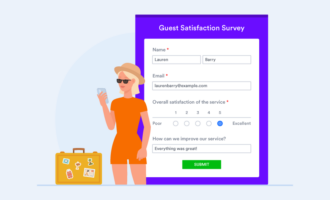Surveys are a great way for organizations to gather feedback from customers, employees, partners, and other stakeholders. With this information in hand, an organization is in a better position to make decisions about the future of the business.
However, designing a survey is no easy task. Determining the right questions to ask to get the data you’re looking for actually takes a good deal of thought. And you need the right survey tools to help you gather that data.
One of the most important aspects to consider when crafting a survey is whether to use qualitative vs quantitative questions. In this article, we cover what these types of questions are, why they’re useful, and when and how to use them effectively in surveys.
Qualitative vs quantitative questions: Key differences
Qualitative and quantitative questions in surveys are both effective ways of getting information from a target audience, but the type of information they provide is fundamentally different. As the name suggests, quantitative questions offer answers that either are numeric or lend themselves to statistical analysis.
For example, the question, “How often do you do your grocery shopping?” is a quantitative question that can help an organization determine how many of their customers shop at specific intervals, such as every three days, five days, or seven days. Another example of a quantitative question is, “Do you prefer the blue sweater or the red sweater?” The answers to that question can be represented by the percentage of customers who chose each option.
Here are other examples:
- Which brand tagline do you like best?
- How often do you shampoo and condition your hair?
- Order the following product features from most helpful to least helpful.
Qualitative questions, on the other hand, aren’t as easy to analyze as quantitative questions because their answers have subtler, more subjective meanings. Qualitative questions focus on the why or how of a topic and elicit deeper and more detailed responses.
For example, the qualitative question, “How would you describe your last customer service experience with our business?” can draw a variety of responses from customers, ranging from one-word answers to multi-paragraph recaps. Whether the replies are short or long, understanding their significance requires you to analyze the sentiment of responses and identify overall patterns in them.
Another example of a qualitative question is, “If you could improve our product, what would you change?” The answers to this question could range from design features to marketing slogans to a complete overhaul, so they may be difficult or impossible to quantify.
Here are other examples:
- What is your opinion on climate change?
- How do you feel about the current product returns process and why?
- What challenges do you experience most often when it comes to grocery shopping?
Benefits of quantitative survey questions
Why should an organization consider using quantitative questions in their surveys? There are many advantages to this question type:
- Simpler analysis: It’s easier to analyze the answers to quantitative (as opposed to qualitative) questions, enabling an organization to analyze a huge number of survey responses.
- Better mobile user experience: Qualitative questions require typing in words or sentences, while quantitative questions typically require checking a box. As a result, the latter are easier to complete on mobile devices.
- More directly actionable insights: Quantitative questions often result in clear-cut insights that organizations can use to make decisions about their business, while qualitative answers often require more interpretation.
Benefits of qualitative survey questions
While qualitative questions result in answers that are hard to quantify, they still provide the organization with useful insights. Here are some advantages this question type can deliver:
- Deeper context: Organizations that want to know more about the causes and effects behind survey results can learn more about audience attitudes, habits, and behaviors, which can be deeply valuable to the business.
- Unexpected replies: The beauty of a qualitative question is that the survey respondent can answer however they please. This often leads to surprising, helpful information that the surveying organization hasn’t previously considered.
- Higher degree of personalization: A qualitative question can help an organization understand their survey respondent on a more personal level because it provides an opportunity for open communication.
When to use quantitative survey questions
“Organizations should use quantitative results to identify patterns and trends in data sets,” says Olivia Tsang, growth marketing director at Fraction, a mortgage lender helping homeowners tap into their home equity. “Companies can collect accurate data with quantitative questions to make predictions and inferences. Additionally, quantitative data can be analyzed and interpreted using statistical analysis if further assessment is required.”
Here are other examples of situations when it’s best to use quantitative questions in a survey:
- An organization wants to survey a large audience. If an organization wants answers from hundreds or thousands of people, it’s best to use quantitative questions so the responses are easier to analyze.
- An organization has a small research budget. Because quantitative questions take less time to analyze, they’re less costly than their qualitative counterparts.
- An organization wants to know quantifiable information. We can’t distill all behaviors down to numbers, but for those we can — such as how often a respondent does something or how likely they are to do something — it’s easier to get the information from quantifiable questions.
- An organization’s audience is primarily on mobile devices. As we mentioned above, quantitative questions are easier to complete on mobile devices than qualitative ones are, so this question type is the best choice for mobile environments.
- An organization is looking for summary insights. Quantitative questions rarely provide deep contextual information, but there are many contexts in which an organization benefits substantially from the bird’s-eye view afforded by numerical patterns in the answers to specific questions.
When to use qualitative survey questions
Since qualitative questions often provide unexpected answers and deep insights, there are certain situations in which these types of survey questions work best.
“Organizations should use qualitative results to know people’s experiences, opinions, and perspectives about a product or service,” says Tsang. “Companies can collect subjective, behavioral-based answers when using qualitative data.”
Here are situations in which an organization should consider using qualitative questions:
- An organization wants to know hard-to-quantify information. It can be difficult to measure a survey respondent’s opinions or attitudes toward a topic and their underlying beliefs or motivations. Qualitative questions provide an opportunity to learn the why and how of such hard-to-quantify information.
- An organization wants to follow up on quantifiable data. Surveys will often follow a quantitative question with a qualitative one, asking for more context or detail relating to the answer the respondent gave to the quantitative question.
- An organization has a small target audience. If an organization querying a relatively small audience wants to get to know respondents on a more personal level and it has the resources to review and analyze the responses, then qualitative questions provide a good opportunity to make connections.
Qualitative vs quantitative questions: The benefits of a blend
While quantitative questions and qualitative questions differ greatly from one another, they can be equally helpful when you use them strategically in a survey. Many surveys include both types of questions. Often, they’re integrated through such techniques as following a quantitative question with a qualitative question on the same topic.
“The lines between qualitative (no closed set of answers) and quantitative (a closed text or numeric answer set with, at most, an ‘Other/Specify’ option) have rightfully been blurred by online methods, including forums, bulletin boards, collaborative editing, virtual white boards, and more,” notes Laurie Gelb, freelance consultant at Profit by Change, a marketing and health outcomes research company.
“Since decisions need to be made quickly and we typically need the understanding provided by both qualitative and quantitative,” Gelb continues, “the best studies often combine the two, whether with a one-time set of stimuli, interval pings, or asynchronous data collection.
“Thoughtful question order and pacing — allowing the respondent time and space to impart structured matters of fact and opinion, [which the surveyor strategically integrates, as appropriate] — allow a survey project to add maximum value. For example, instead of asking ‘What else?’ or ‘Do you have any other comments?’ it may be appropriate to ask, ‘If you became president of this firm tomorrow, what would be your first move?’”
Jotform: The solution to your qualitative and quantitative question needs
Whether an organization is using quantitative questions, qualitative questions, or a combination of both in their surveys, Jotform is the ideal survey maker for businesses of all sizes and types. It offers hundreds of survey templates, so a lot of the hard work is already done.
Organizations can use Jotform’s drag-and-drop survey builder to customize a survey to their exact requirements, choosing from multiple quantitative and qualitative question types to include in the questionnaire. In addition, Jotform integrates with many enterprise solutions, such as customer relationship management (CRM) and email marketing tools, making it easy to connect the survey responses to the business as a whole. It enables organizations to create surveys that result in valuable insights — regardless of whether they come from qualitative or quantitative questions.
Photo by Cup of Couple






































































































Send Comment: